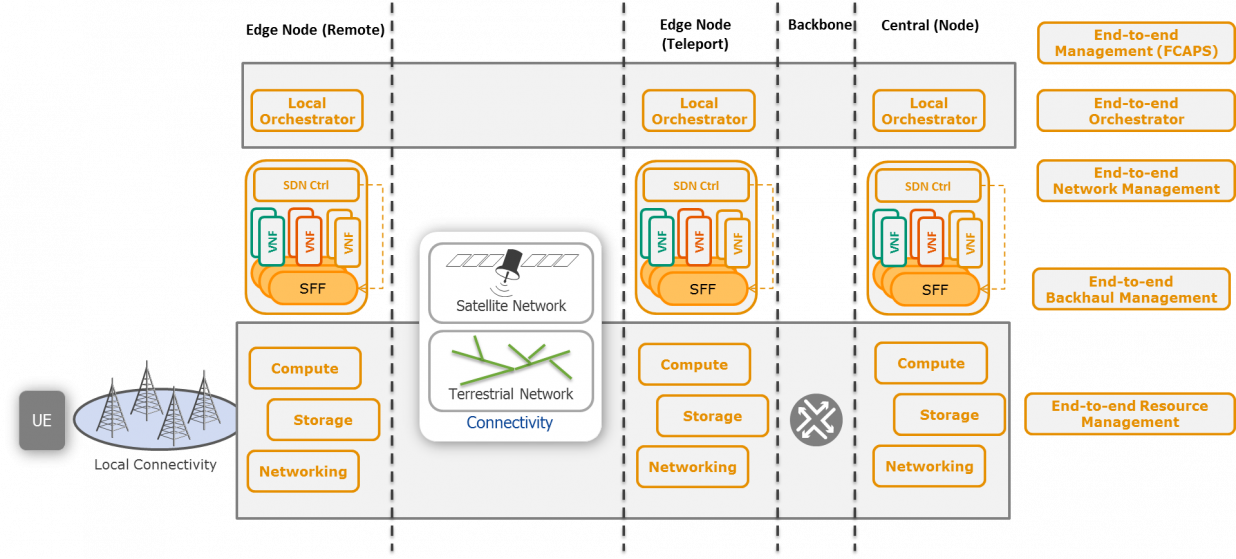
-
StatusCompleted
-
Status date2024-06-14
-
Activity Code1C.044
EdgeSAT objectives are as follows:
- Identify and review SatCom connectivity scenarios benefiting from edge networking capabilities;
- Define Reference Architecture(s), identify critical functionalities, issues and potential solutions, building upon Multi-access Edge Computing, MAMS and/or 3GPP IAB, xRAN/ORAN specifications;
- Detail the satellite enabled edge node architectures and requirements, including embedded computing/processing capabilities, and dimension and assess such capabilities according to the deployment use cases;
- Specify Application Programming Interfaces (API) in order to ease services development on top of satellite enabled edge node architectures;
- Investigate the impact to the overall service value chain and identify the business models needed to monetize the proposed infrastructure developments;
- Demonstrate how an existing SatCom system could evolve in order to satisfy some of the identified use cases, with special attention to the coexistence and integration with terrestrial access networks and backhaul links, the management of the edge node resources and the scalability performance with large number of edge nodes;
- Formulate a set of recommendations and strategic actions necessary for the European & Canadian industry to be able to address identified opportunities.
- Formulate contributions to standardization bodies as and where applicable.
EdgeSAT is addressing edge network computing from the satellite perspective. Edge network computing is a widely adopted concept among the terrestrial communication actors. From the perspective of EdgeSAT the challenge is the global alignment of edge computing capabilities for satellite remote terminals in a global uniform network currently being developed in 5G.
Edge networking is a concept that is perceived to offer substantial benefits in a number of scenarios to improve advanced services delivery and is widely pursued by the terrestrial communication community. EdgeSAT’s ambition is to bring to the SatCom industry the benefits of edge networking concepts and capabilities and support SatCom to reap them.
EdgeSAT provides a reference architecture for SatCom enabled edge nodes, as well as specification and design for the SatCom enabled edge nodes.
In the core of EdgeSAT is the establishment of a SatCom enabled edge node reference architecture.
The simplified system architecture is as follows:

The above architecture considers the following additional functionalities:
-
End-to-end resource management;
-
End-to-end backhaul management;
-
End-to-end network management;
-
End-to-end resource orchestration.
EdgeSAT has a straightforward development plan of consecutive technical tasks focusing on:
-
Connectivity scenarios and edge networking requirements;
-
SatCom enabled edge node reference architecture;
-
SatCom enabled edge node specification and design;
-
SatCom enabled edge node implementation and performance validation;
-
Recommendations and roadmap;
Business aspects and value chains form an integral part of the technical tasks.
The EdgeSAT study has completed successfully in 2020, after which its testbed was made available to the Agency for 12 months.
The main results of EdgeSAT were presented at the Space2Connect conference in October 2021.
EdgeSAT identified SatCom connectivity scenarios benefiting from edge networking capabilities. It defined a reference architecture for implementing edge networking capabilities in those SatCom connectivity scenarios. Throughout EdgeSAT the 5G multi-access edge computing approach was considered as a cornerstone element. The EdegSAT activity reviewed and investigated critical enabling technologies and solutions. In particular, it analysed the satellite enabled edge node architectures and the requirements for them in terms of embedded computing/processing capabilities, and assessed and dimensioned such capabilities according to the deployment use cases. Furthermore, EdgeSAT specified an Application Programming Interface (API) in order to ease services development on top of satellite enabled edge node architectures.
EdgeSAT also investigated the impact of the merging edge networking capabilities in remote satellite terminals to the overall service value chain and identified business models needed to monetize the proposed infrastructure developments.
Finally, EdgeSAT demonstrated how an existing SatCom system could evolve in order to satisfy selected use cases, including coexistence and integration with terrestrial access networks and backhaul links, the management of the edge node resources and the scalability performance with large number of edge nodes.
EdgeSAT concluded by formulating a set of recommendations and strategic actions necessary for the European & Canadian industry to be able to successfully address the identified opportunities.





